
Factory of John Dwight, England (Fulham), 1670-1859. Covered Tankard, ca. 1685-1690. Stoneware with salt glaze, height: 10 1/2 inches (26.7 cm). The Nelson-Atkins Museum of Art, Kansas City, Missouri. Gift of Frank P. Burnap, 55-77 A, B. Photograph by Jamison Miller.
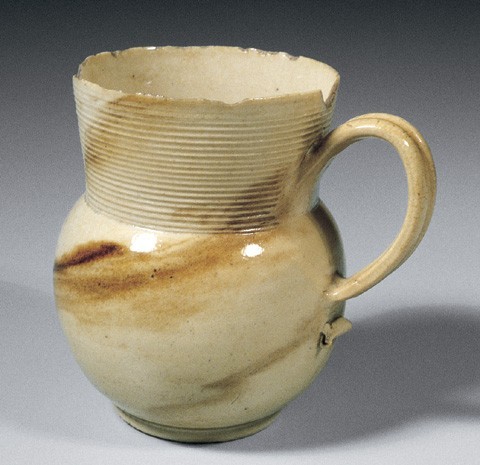
Mug, Francis Place, Yorkshire, ca. 1680. Salt-glazed stoneware. H. 3 1/2". (Courtesy, Mint Museum of Art, Charlotte, North Carolina. Gift of the Delhom Service League; photo, David Ramsey.)
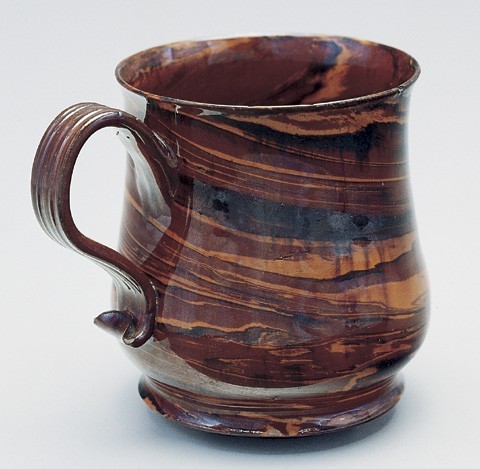
Mug, attributed to Samuel Bell, Staffordshire (Newcastle-under-Lyme), ca. 1740. Lead-glazed agateware. H. 4 1/2". (Courtesy, Troy D. Chappell Collection; photos by Gavin Ashworth unless otherwise noted.)

Dish, Staffordshire, ca. 1780. Lead-glazed agateware. D. 6 1/2". (Photo, Robert Hunter.) Dishes of this type appear to have been imported into America in large quantities as they are commonly found in archaeological excavations of the last quarter of the eighteenth century. It is uncertain if the agate effect was intentional or the result of using a mixture of different clays intended to create a better body. Precedent for the latter is found in the so-called Buckley wares made in North Wales from ca. 1720 to 1780, although this ware was covered in a thick black glaze and the agate body is generally not visible.
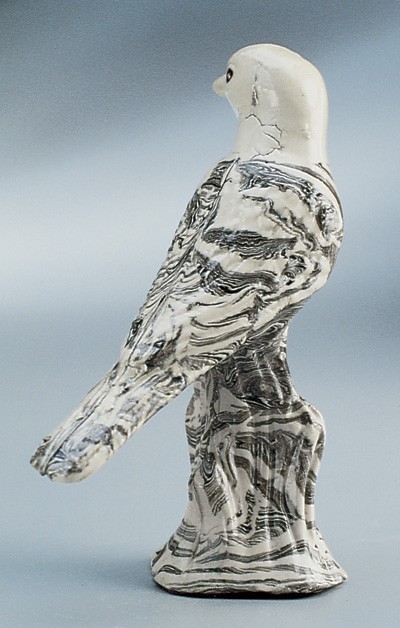
Bird, Staffordshire, ca. 1755. Salt-glazed agateware. H. 5 1/4". (Chipstone Foundation.) Only two colors of clay were used for this laid agate body. On other figures, particularly a group of press-molded cats, cobalt is often added.
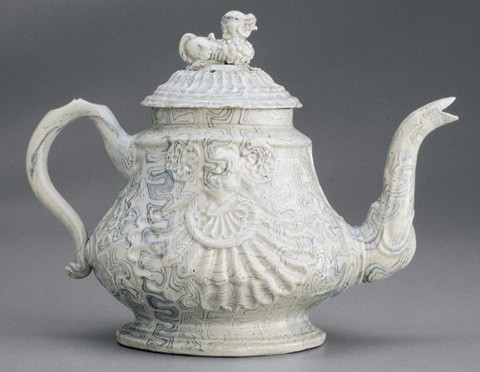
Teapot, Staffordshire, ca. 1755. Salt-glazed agateware. H. 5 5/8". (Chipstone Foundation.) Most of the salt-glazed laid agateware consisted of two colors although three-color examples exist. The orientation of this relatively simple agate pattern, sometimes called “elephant’s tooth” by collectors, is arranged in vertical strips.
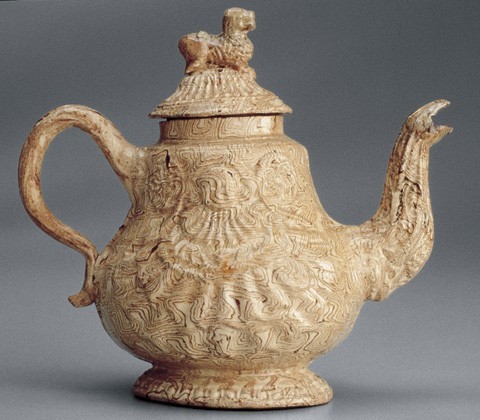
Teapot, Staffordshire, England, ca. 1755. Lead-glazed agateware. H. 5 3/4". (Chipstone Foundation.) Two colors of earthenware clay were used for this shell shaped teapot. This is similar to the pattern illustrated in fig. 6, but with a horizontal orientation.

Footed censers, China, T’ang Dynasty. Agateware. H. 3" and 2 7/8". (Courtesy, Bonhams & Butterfields Auctioneers.)
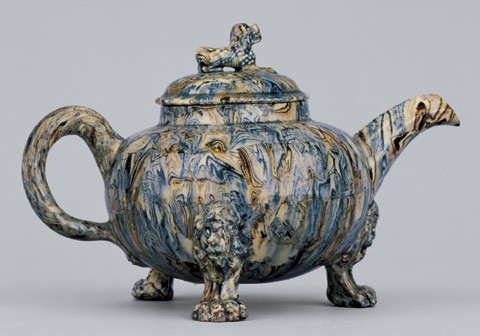
Teapot, Staffordshire, ca. 1750. Lead-glazed agateware. H. 5". (Courtesy, Colonial Williamsburg Foundation.) Note the identical shape to the Chinese censers illustrated in fig. 8.
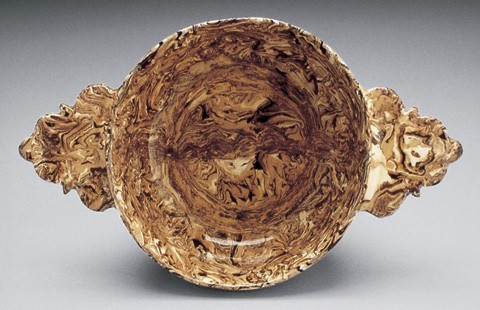
Porringer, Apt, France, ca. 1770. Lead-glazed agateware. L. 9 1/2". (Chipstone Foundation.)
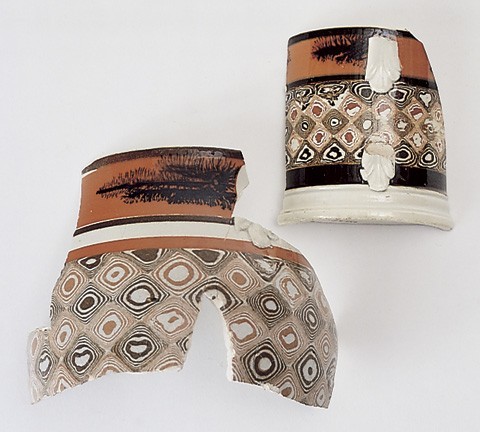
Mug and jug fragments, Staffordshire, ca. 1785. Pearlware. (Courtesy, Alexandria Archaeology.) Fragments from these similarly slip-decorated vessels are highlighted with a sheet of agate inlaid in the bodies.

Detail of the agate inlay in the fragments illustrated in fig. 11. This pattern is created with alternating black-and-white and red-and-white squares of agate clay.
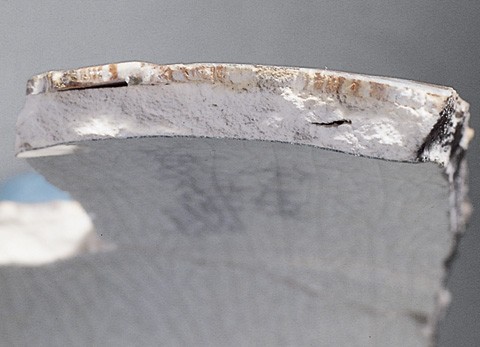
Detail of the fragment section illustrated in fig. 12 showing the thin solid sheet of agate veneered to the surface of the pearlware body. After the agate sheet was inlaid, the vessel was trimmed on a lathe to reveal this distinct pattern.

Tobacco pipes, Emanuel Drue, Maryland, 1650–1669. Earthenware. (Courtesy, Al Luckenbach.) These pipe fragments probably represent the earliest use of the agate technique in colonial America. The agate pattern was created using naturally occurring colored clays. Similar examples of Dutch tobacco pipes have been found in a circa 1620 context at Martin’s Hundred in Virginia.
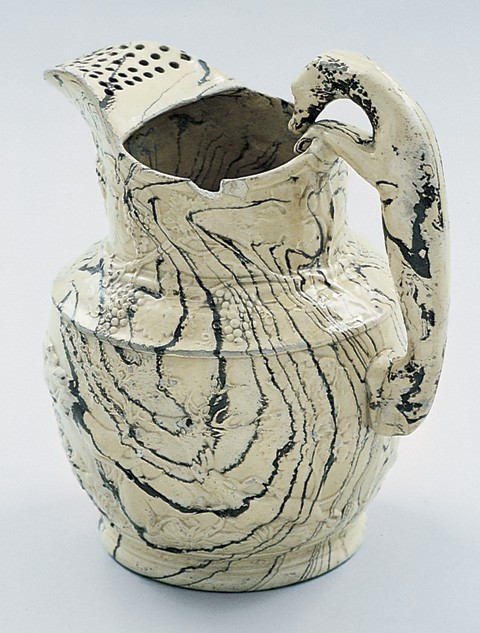
Pitcher, U.S. Pottery Company, Bennington, Vermont, ca. 1853. Lead-glazed agateware. H. 11 3/8". (Courtesy, The Bennington Museum.) This pitcher was designed by Daniel Greatbach. Ceramics historian John Spargo writes that scroddled ware was manufactured in the nineteenth century exactly as it was in eighteenth-century Staffordshire.

Vase, Evans Pottery, ca. 1950. H. 10 1/2". (Private collection.)

Vase, North State Pottery, North Carolina, ca. 1930. H. 9 1/2". (Private collection.) This thrown agate vase demonstrates extremely vigorous striations of clays. The interior is lead glazed.

In preparing the clay for throwing an agateware mug, slabs of varied colored earthenware clays are cut and stacked. At this stage the proportion of the colored clays determine the intensity of the agate patterning. Three colored clays are selected for making a mug: a white clay, a red iron clay, and an iron manganese body.

The slabs are then stacked in alternating colors. After the initial stacking, the clay is sliced in half and restacked to start with an even distribution of layers.

The clay is carefully wedged or kneaded to prepare it for throwing. Care has to be taken at this stage to expel air from the clay without overworking the clays. The more the clays are wedged the less distinct the resulting agate pattern.
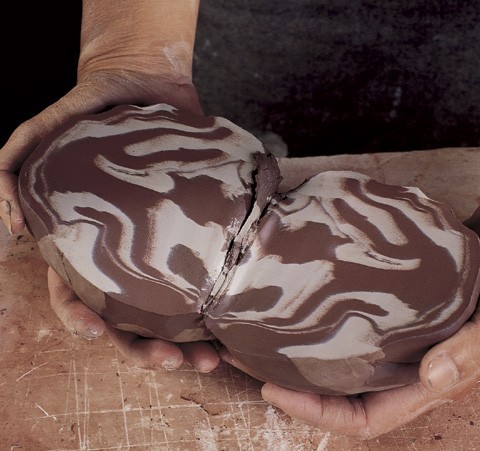
For demonstration purposes, the wedged ball is cut to show the pattern prior to throwing. Restacking these halves can improve the quality of the agate patterning in the finished product.
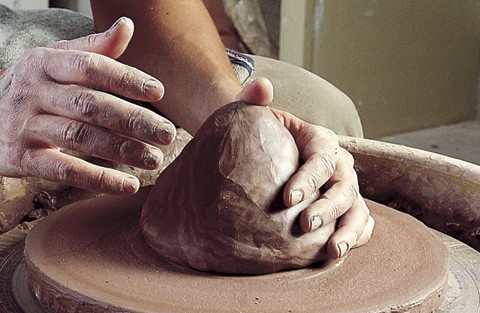
The prepared agate clay ball is centered on the wheel.
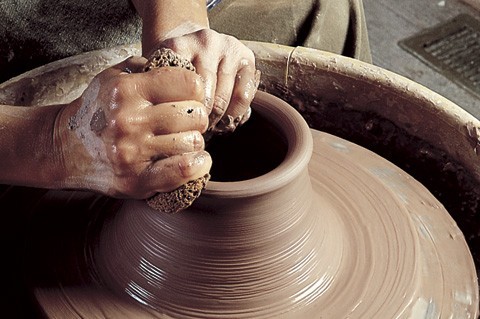
Once centered, the clay ball is opened and pulled quickly into a cylinder. During the throwing process it is important not to overwork the clay as this will lessen the distinctions between the colors.

The cylinder is shaped into the final mug form. Note how the muddy surface has concealed the agate patterning.

The final contours are shaped using a metal rib, and the muddy exterior of the thrown mug is scraped away, revealing the agate pattern.
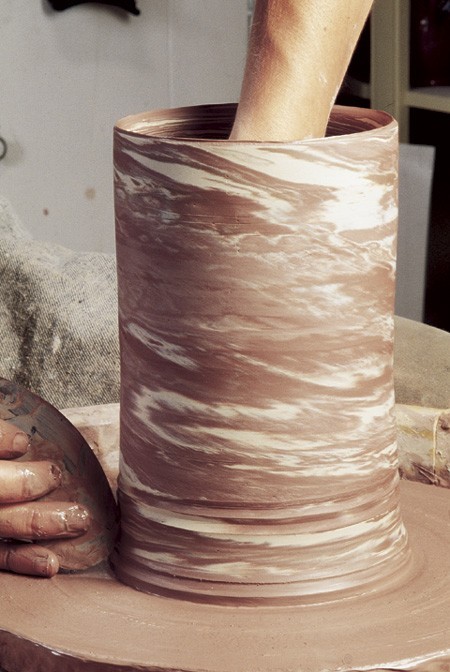
Final finishing of the thrown mug.

Interior of the mug being scraped to reveal the agate pattern.
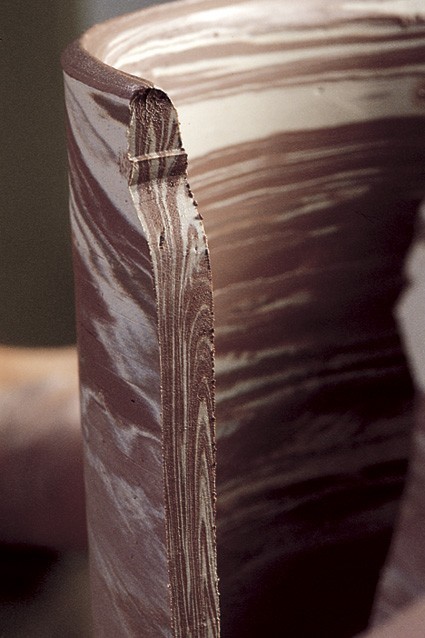
The thrown mug is sliced to reveal a cross-section of the body that shows the solid agate pattern and uniform thickness of the wall. Even wall thickness is important to the success of the next step.

In the production of eighteenth-century Staffordshire hollow wares, the forms are affixed to a lathe for final trimming. After this stage, a handle is pulled or extruded from an agate clay ball and attached to the mug. Subsequently, the mug is dried, fired to biscuit, glazed, and refired.
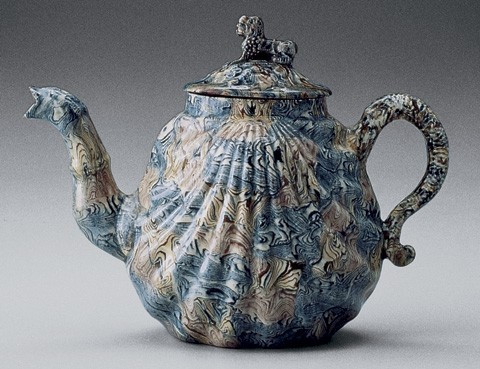
Teapot, Staffordshire, 1745–1755. Lead-glazed agateware. H. 5 1/8". (Chipstone Foundation.) An example of a press-molded pecten shaped teapot. Note the seemingly naturalistic patterning of the laid agate which exhibits alternate squares of cobalt colored clay. This antique specimen serves as the prototype for the demonstration of the laid agate techniques.

Four colors of clay slabs. A base white earthenware is in the foreground. The other slabs have been colored with (left to right): iron oxide, manganese oxide, and cobalt carbonate.

A slab of iron enriched red clay is laid onto a base white clay of the same length and width. The slab of white clay is approximately three times as thick.
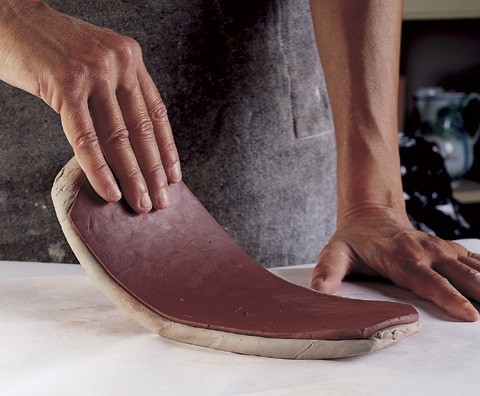
The combined slabs are repeatedly slammed on the table to stretch and thin the layers. This process of using the clay’s natural properties to achieve the thinning is a simple but elegant solution.
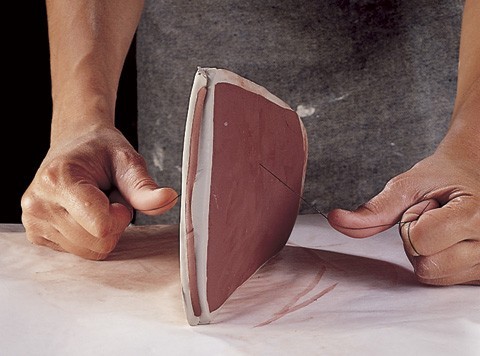
The combined clay slab is cut in half and the two pieces restacked. This process is repeated, continuously adding and thinning the layers.
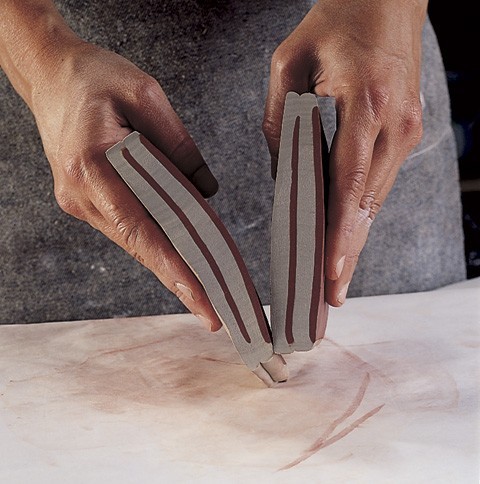
The slab after cutting the second time showing two layers.

Cutting the slab in half after several repeated steps of stacking and thinning.

Cross-sections of the stacking and thinning process.
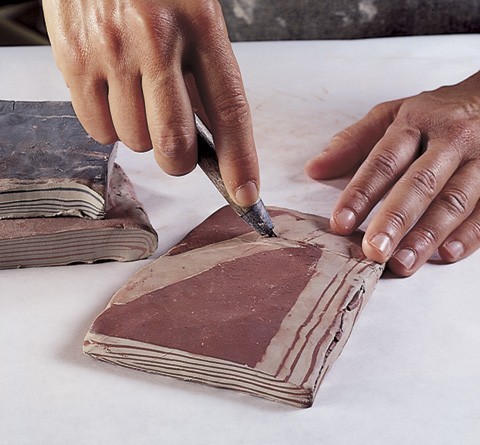
The three color clay slabs are prepared in the same way. The layered slabs are then trimmed to equal rectangular sizes.

A coil is formed with each slab and cut from the slab. Several coils can be made from each slab.

The coils are further rolled into cylindrical shapes.
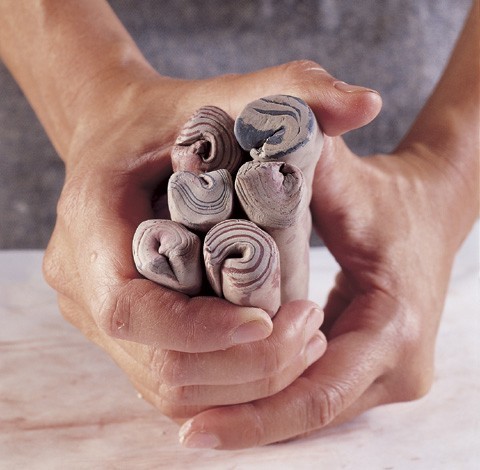
The rolled coils are arranged in alternating colors. At this stage, particular attention is paid to the arrangement of the individual colors. Note the similarities to the laid agate pattern illustrated in fig. 11.
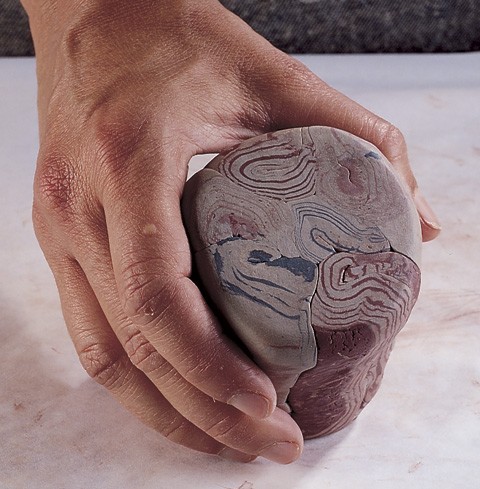
The coils are pressed into a solid cylindrical mass.
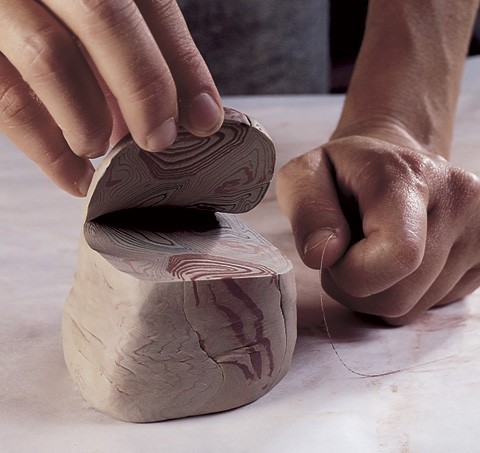
The mass is squared off and thin sections are cut from the stack revealing the beginnings of the agate pattern.
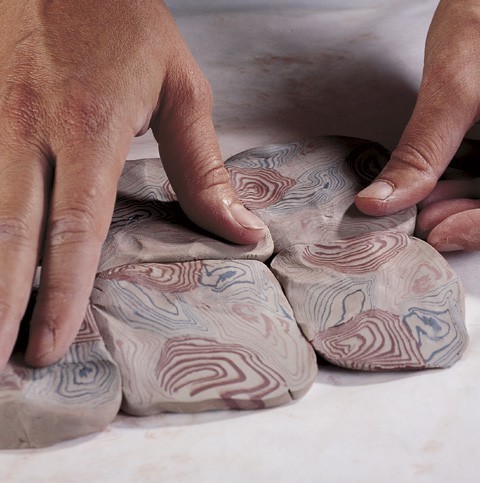
The sections are arranged and carefully pushed together on a flat surface alternating the patterns.
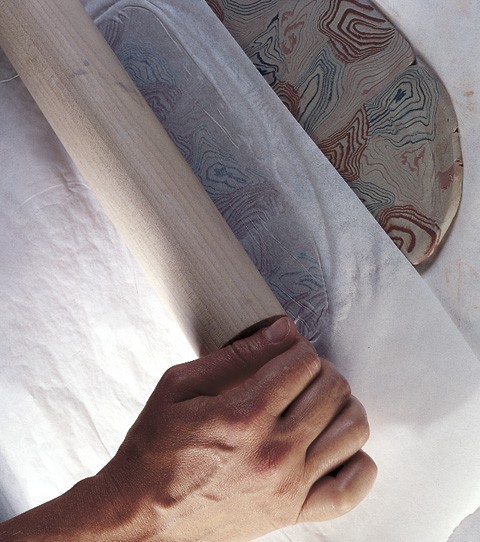
The sections are joined and flattened using a rolling pin. The paper provides a barrier to keep the pattern crisp and the clay from sticking to the rolling pin. The paper will be changed frequently during the next several steps to prevent smudging the surface.
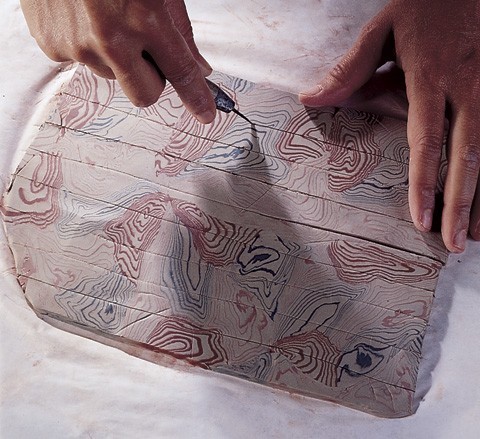
After a flat slab is prepared, regular strips of clay are cut in a horizontal plane.
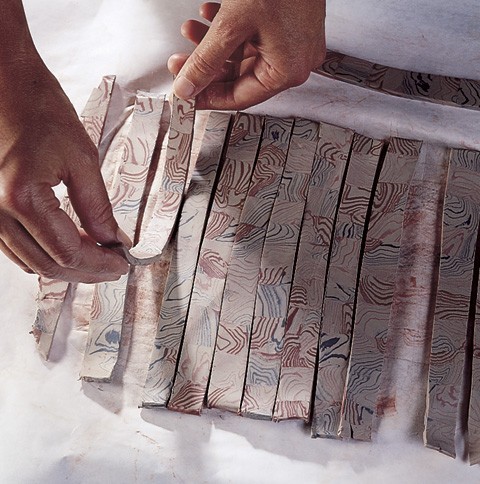
The cut strips are rearranged to accentuate the agate pattern and joined again by rolling to a uniform flat slab.
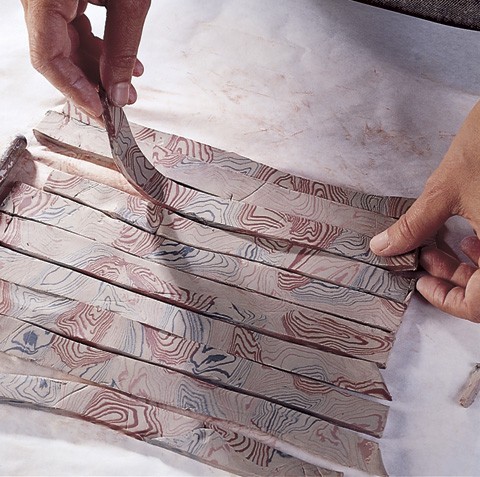
Strips of clay are once again cut from the newly made slab, this time in a vertical plane.
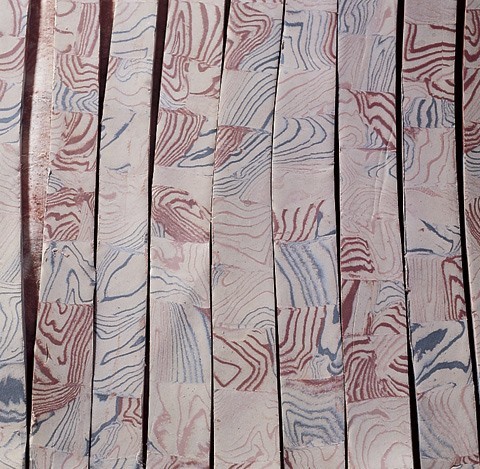
The strips are rearranged to intensify the agate pattern and rolled again.
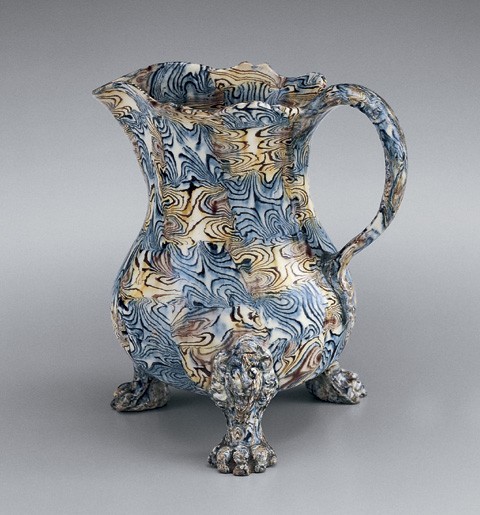
Cream jug, Staffordshire, ca. 1750. Lead-glazed agateware. H. 10". (Chipstone Foundation.) The body of this jug was formed in a two piece press mold. The cabriole feet were molded separately and applied, as was the handle.
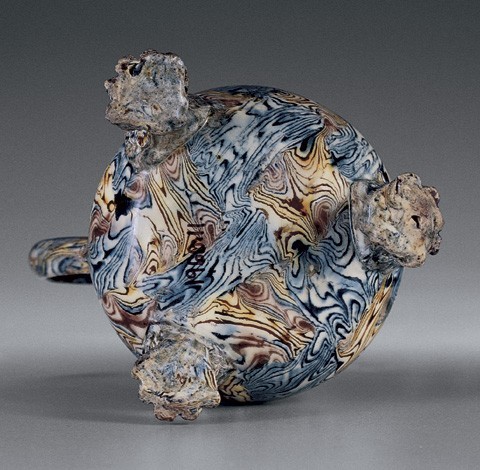
Bottom view of the cream jug illustrated in fig. 50. Note the checkerboard patterning of the agate strips which have been arranged in an alternate pattern. This view also shows the smeary patterning of the molded cabriole feet.

The final agate slab. At this stage, the checkerboard pattern created by both horizontal and vertical cutting is readily observed. For the demonstration, the patterning of the agate has been left moderately coarse so that is it easily observable in the photographs. The slab is now usable.

The thin agate slab being laid into the plaster press mold.
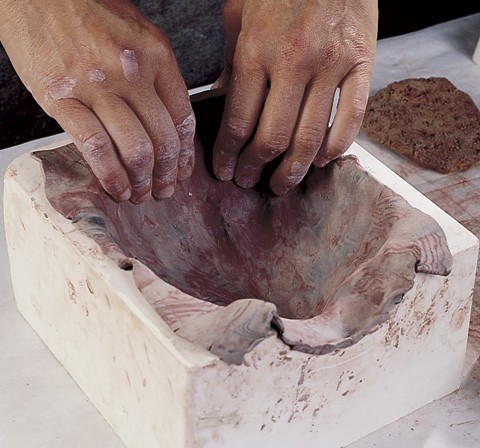
The slab is then pressed firmly into the concavities of the mold. Great care is taken to work the clay gradually into the recesses of the mold without tearing along the many seams in the agate sheet. Pressure from the fingers muddies the interior of the agate surface.

The slab is allowed time to firm up within the mold so the completed teapot half being removed is without distortion.

The two piece molds necessary for producing a pecten shell teapot including the body, spout, handle, and Fo Lion finial. These molds were taken from original master models sculpted by Michelle Erickson.

Once two halves are pressed in separate molds, they are ready to be joined. The edges are lightly scored and moistened. The two molds are aligned, and the seam is closed by working from the inside through the opening in the neck. After being joined, the teapot body is removed from the molds and the exterior seam is carefully smoothed and finished before attaching the spout and handle.

The assembled pecten shell teapot. The pot is now slowly air dried. Once dried, it is possible to enhance the agate surface with a light scrubbing using the equivalent of a fine steel wool. Any heavy smudging or distortion cannot be altered. The pot is fired to biscuit, glazed, and fired again.

Coffee pot and lid, Staffordshire, ca. 1750. Lead-glazed agateware. H. 7 5/8". (Chipstone Foundation.) The body of this eight paneled coffee pot was made in a press mold. The handle, spout, and foot were molded separately and applied. The matching lid and the Fo Lion finial were molded separately as well. Note that this agate pattern was created using a variation on the technique.
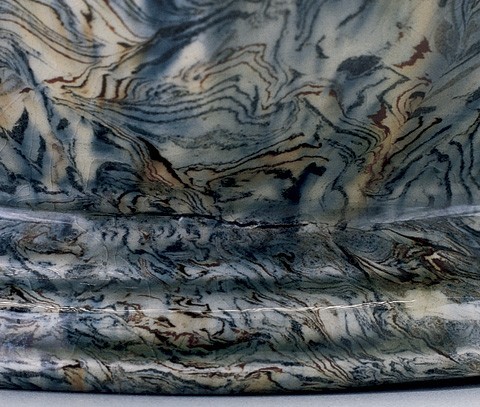
Detail of the applied foot on the coffee pot illustrated in fig. 59. The foot was separately molded and applied. The point of attachment can be distinguished by the discontinuities in the agate patterning and the slight separation crack that opened during later drying or firing.

Waste bowl, Staffordshire, ca. 1750. Lead-glazed agateware. D. 5". (Chipstone Foundation.) A form that is typically thrown, this bowl had to be press molded using laid agate clays. Examination of antique agateware bowls and sauce boats indicate that two thin sheets of agateware clay were laminated during the molding process to create the interior and exterior patterns.
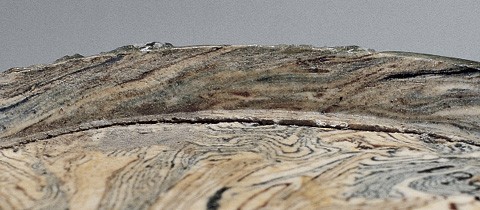
Detail of the foot attachment to the bowl illustrated in fig. 61. Note the distinct separation where the foot pulled away from bowl during the finishing process. Also note the distortion of the agate pattern on the interior of the foot.
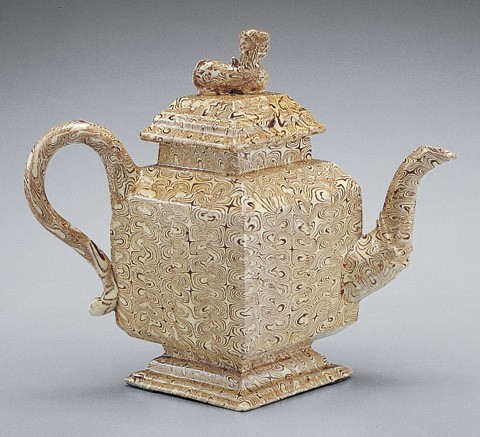
Teapot, Staffordshire, 1745– 1750. Lead-glazed agateware. H. 5 3/4". (Courtesy, Troy D. Chappell Collection.) The two-colored agate pattern used for this diamond shaped teapot has been commonly called “elephant’s tooth” by collectors.
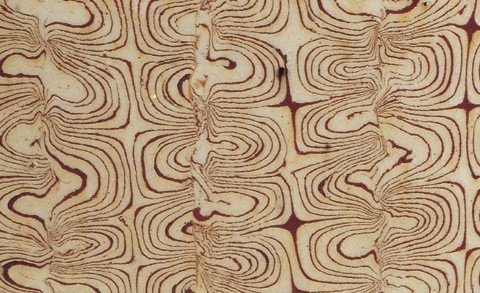
Detail of the agate pattern on the teapot illustrated in fig. 63. Note the purposeful placement of both vertical and horizontal strips. Compare this relatively simple agate pattern with the stage of preparation illustrated in fig. 41.

Teapot, Staffordshire, 1745– 1755. Lead-glazed agateware. H. 5 1/8". (Chipstone Foundation.) Although the form of this teapot is similar to that illustrated in fig. 63, an unusual three colored agate pattern is used. The effect is that of matched veneers similar to what one may see on furniture construction. The actual technique used to create this pattern needs further exploration.
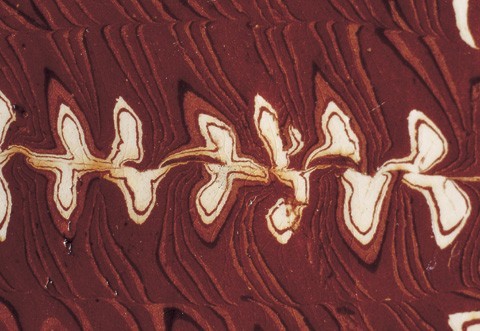
Detail of the agate pattern from the teapot illustrated in fig. 65.
Previously the authors reviewed the use of slips—liquid clays—to create a marbled effect on the surface of a clay object.[1] In this article, we examine how two or more colors of clay are used to make a variegated ceramic body generally known as agateware. Although these two terms are sometimes confused, marbled decoration implies a surface treatment whereas agateware refers to a solid clay fabric.
Semiprecious stones, such as agate, are some of the most beautiful of all substances. They were prevalent as design elements in Chinese, Greek, and Roman societies and often associated with nobility. The use of multiple colored clays to imitate agate can be traced to antiquity as well. Beginning in the late seventeenth century, this technique was used to fashion a class of English ceramics recognized as agateware.
English agateware has been made for useful and ornamental purposes, collected, and written about for several centuries. However, only limited discussions of production methods have been published, which run the gamut from fairly accurate to wildly speculative. In addition, these descriptions have not contained illustrations of agateware techniques.[2]
Our approach to decoding and recreating English agateware began with the information contained in the actual wares themselves. Careful examination and considerable trial and error experimentation produced results that we are now able to demonstrate. Insights gained from this preliminary exploration should help frame further questions about the manufacture of agateware and its place in eighteenth-century consumer society.
Agateware can be divided into two broad categories: thrown agate and laid agate. Thrown agate describes a vessel formed on a wheel using a prepared mixture of various colored clays. Laid agate refers to an object created from a thin sheet or bat made of agate clay. This thin sheet is draped or laid in the mold and pressed into shape—hence our use of the term laid.[3] Both types of agateware continue to be produced commercially as well as employed in the repertoire of the contemporary studio potter.[4]
HISTORY OF PRODUCTION
English Thrown Agate
The earliest documented agateware is found among the products of John Dwight (even though he himself referred to it as marbled). Considered by many as the father of English pottery, Dwight is well known in the annals of ceramic history for his innovations (fig. 1). He conducted numerous ceramic experiments beginning in the 1670s, delved into the mysteries of porcelain, and recorded his recipe to produce “marbled” stoneware:
A dark colour’d Cley for marbled dishes and Teapots to endure boiling Water
Take fine dark Earth ten pounds
fine white Earth Eleaven pound
Cley Sifted one & twenty pounds
White Sifted through Cyprus Sieve
Six pounds, mingle & tread
Included with the instructions are these comments:
Note y t this dark colours; the mouse colourd, & the dish white Cleyes, agree best together to marke marbled Vefsells, that will burne Every where, & Endure boiling Water.
But to make marbled gorges or Cans, the gorge white may be used instead of the dish-white, because it works Stronger upon ye wheel.[5]
Dwight’s notes reveal two important material considerations in making an agate body: clay color and clay compatibility.
To create the illusion of agate striations, different color clays must be obtained naturally or by modification, adding pigments or coloring agents. The tone of a natural clay can also be altered by sieving to remove impurities such as iron and sand.
Creating a successful variegated appearance also depends on the proportions of clay colors used. Dwight’s recipe required equal parts of dark (ten pounds) and white (eleven pounds) clay and an additional six pounds of white clay passed through a Cyprus sieve. Named for the silk material used for the mesh, this type of sieve had the smallest or finest opening available at the time. For the first of these colors, Dwight’s notebooks contain instructions for making “a dark earth”—a clay artificially stained with iron oxides obtained from the hammer scale of a blacksmith’s forge. The second color, the fine white, may be a natural pale- to mid-gray clay. Research shows that specimens of the final color—the six pounds of sifted white clay—are pure white and have virtually no macroscopically visible inclusions.[6]
Clues for understanding problems related to combining multiple clays are also contained in Dwight’s formula. These include shrinkage rates, firing temperatures, density, plasticity, elasticity, and strength. All of these properties must be considered when mixing dissimilar clay bodies.
When Dwight writes that these “dark colours; the mouse colourd, & the dish white Cleyes, agree best together to marke marbled Vefsells, that will burne Every where, & Endure boiling Water,” he is referring to the ability of clays to blend successfully to throw properly, to survive the firing without splitting or warping, and, as a finished product, to withstand the thermal shock from boiling water. In considering the agate clay’s working capabilities, Dwight prescribes that “the gorge white may be used instead of the dish-white, because it works Stronger upon ye wheel.” The term “Stronger” means that the clay could be better pulled up on the wheel and into a cylinder without distortion or collapse.
Today, only a few of Dwight’s “marbled” or agatewares survive.[7] In addition, some agateware fragments have been recovered from archaeological excavations of his pottery site in Fulham. These fragments include examples of a tankard, a gorge (or mug), a cappuchine (coffee cup), and a teapot. The discovery of a teapot underscores Dwight’s concerns expressed in his recipe note that the clay could “Endure” boiling water.[8]
It is hard to judge whether Dwight’s agateware was received as a novelty or as an important scientific discovery. Evidence for the latter may be suggested by the “marbled” salt-glazed stoneware of Francis Place of York (fig. 2). Primarily an artist and engraver, Place was also a dilettante with eclectic interests, and he prominently included a mug in the foreground of his circa 1680 self-portrait. As part of a growing group of gentlemen-artists who studied every new artistic and scientific inquiry in English society, Place was undoubtedly inspired by the growing national interest in new ceramic discoveries which would lead to many technological breakthroughs in the eighteenth-century English ceramic industry.[9]
Commercial production of English agateware does not begin in earnest until the second quarter of the eighteenth century. In 1729, Samuel Bell, at the Lower Street potworks, Newcastle-under-Lyme, was granted a patent to produce “red marbled stoneware with mineral earth found within this kingdom which being firmly united by fire will make it capable of receiving a gloss so beautiful as to imitate if not compare with ruby.”[10] Like Dwight’s agate, the Bell products were thrown on the wheel. After being initially formed, the wares were turned on the lathe to thin the body and concurrently create a clean variegated surface. These wares typically had a red and off-white clay body even though a black colored clay was used.
Contrary to the wording of the patent, Bell’s agateware is earthenware rather than stoneware. These wares are distinguished for being the earliest known twice-fired earthenware in Staffordshire, first being fired to a biscuit state then dipped into a liquid lead glaze and fired again. The wording in his patent “being firmly united by fire” may reflect Bell’s recognition of the potential problems of successfully integrating different clays into a single ceramic body.
Archaeological evidence from the excavation of Staffordshire factory sites, including that of John Bell and of John Astbury at Shelton Farm, shows that many potters made this type of thrown agate. Tea wares were the most common forms made, although mugs and bowls were also produced (fig. 3). Thrown agate reached its height of popularity in the 1750s and continued in production into the early 1770s.[11]
At that time, a coarser type of thrown agateware was introduced in Staffordshire. Used primarily for plates, dishes, and bowls, these wares frequently included rouletted bands of white slip decoration. This utilitarian agateware is commonly found in American archaeological sites of the 1770s and 1780s (fig. 4). Thrown agate production all but disappeared in Staffordshire by the late eighteenth century but continued sporadically in other pottery centers such as Sussex in the nineteenth century.[12]
English Laid Agate
The second quarter of the eighteenth century saw many innovations in the Staffordshire potteries. One of these was the use of molds for creating forms either by slip casting or pressing. Press molding permitted new possibilities for developing agate bodies (figs. 5-7).
Laid agateware is inherently different from thrown agateware in that the pattern must first be prepared before the shape is made. In other words, the decoration is made before the pot. It is uncertain exactly when the laid agate technique was developed in Staffordshire. Ceramic historian Simeon Shaw mentions Dr. Thomas Wedgwood of Burslem (1695–1737) as the earliest potter associated with the process. Apparently his products included “Coffee and Tea Pots, of clays compounded and mixed to resemble agate, marble, and other natural bodies, . . . in various shapes; some glazed with lead ore; and the white, all salt glaze.” Shaw continues, “Had the agate rising genius of that day been adequately encouraged, doubtless many important improvements would have resulted.”[13]
Another likely candidate is Thomas Whieldon of Fenton Low (1719– 1795). Whieldon is most often recognized for his improvements in agateware undertaken in the 1740s, including the use of white clays stained with metallic oxides.[14] Still, a firm date for the beginning of laid agate in Staffordshire has yet to be established, although an agateware dish with the inscribed date of 1746 may be the earliest documented example that exists.[15]
Beyond the date of its introduction, however, the source of the laid agate pattern is perhaps the more important inquiry. Several writers have been hesitant to make this correlation, but, for us, it is clear that eighth-century T’ang dynasty Chinese wares inspired many eighteenth-century Staffordshire laid agatewares. The relationship is most obviously visible in the form of globular censers, or incense burners, which are of the same size and shape as the Staffordshire teapots (figs. 8, 9).[16]
The imitation of eighth-century Chinese ceramics by Staffordshire potters is not as improbable as it may seem at first. It is known that contemporary Chinese porcelains and Yixing stonewares served as direct prototypes for many eighteenth-century Staffordshire tea wares. It is likely that older Chinese wares resided in European and English antiquarian collections. Such antique wares were sought for the “cabinets of curiosities” of the English cognoscenti. Intriguingly, the cabinets belonging to these scientifically minded collectors often included “agates, onyxes and intaglios.”[17]
If Thomas Whieldon is responsible for deciphering the Chinese laid agate technique and introducing it in the Staffordshire potteries, he must have studied antique examples at length. In 1754, Whieldon entered into a partnership with young Josiah Wedgwood. Excavations at Whieldon’s manufactory at Fenton Vivian revealed a number of laid agate wasters, which appeared to have been manufactured during the period of the partnership.[18] One of the most often cited agateware references comes from Josiah Wedgwood’s experiment book on March 23, 1759: “I had already made an imitation of Agat which was esteem’d very beautiful, and a considerable improvement . . . .”[19] Just how much he improved the agateware process and whether he had a direct hand in copying Chinese prototypes is undocumented.
Josiah Wedgwood concluded his partnership with Whieldon that year and went into business for himself. He continued to refine the agate technology for decorating his ornamental vases. Wedgwood used both solid agates and marbled slip techniques at his Etruria factory into the 1780s. Rather than copies of Chinese prototypes, the vases were directly inspired by antique Etruscan and Roman examples.[20]
Agateware made on the Continent is occasionally confused with Staffordshire specimens (fig. 10). Close examination usually reveals both significant differences in the agate veining and vessel forms. In addition, the earliest known French agateware made by Francius Moulina and Jacques Barthelemy in Apt, France, beginning in 1768, was almost two decades later than the main production period in Staffordshire. Other laid agateware was made through the nineteenth century at several European centers.[21]
In the later part of the eighteenth century, some Staffordshire potters applied laid agate to utilitarian creamwares and pearlwares. Used in conjunction with mocha-type slip decoration, these examples had an agate sheet laminated to the surface (figs. 11-13). This so-called surface agate or inlaid agate, although seemingly a laborious method of decoration, was still practical enough to embellish these inexpensive earthenwares.[22]
American Agateware
In America the use of agate clays is occasionally seen on domestically produced redware in the seventeenth and eighteenth centuries. Indeed, the earliest documented use of agateware technology comes with the circa 1650–1669 tobacco pipe kiln of Emanuel Drue in Maryland (fig. 14).[23] However, the best-known examples of American agateware are the nineteenth-century products of the U.S. Pottery Company in Bennington, Vermont, termed “scroddled ware,” although the company called the ware “Lava” (fig. 15).[24]
A number of nineteenth-century American potteries used agate clays to manufacture doorknobs covered with a Rockingham glaze. In the twentieth century, agateware makes a brief appearance in the arts and crafts movement, most notably in the “Mission Swirl” line of the Niloak Pottery Company in Benton, Arkansas (fig. 16). Another thrown agate of this general type was produced by North State Pottery of North Carolina (fig. 17) in the 1920s and 1930s.
DEMONSTRATION OF AGATEWARE TECHNIQUES
Thrown Agateware Techniques
The key step in creating an agateware body can be summed up in three words: preparation, preparation, preparation! For creating thrown agate, the initial selecting and mixing of clays is critical (fig. 18). To begin, clay slabs are built up, alternating the colors (fig. 19). This stack is then wedged or folded to form a ball that can then be thrown on the wheel (fig. 20). Care has to be taken during wedging to ensure the clays are mixed without overly distorting or blurring the resultant agate pattern (fig. 21). The degree of success in an agate pattern comes from the initial wedging process as well as the throwing.
The prepared clay ball is then centered on the wheel (fig. 22). During throwing, the surface of the clay body becomes smeared so that agate patterning is obscured (figs. 23-28). Care has to be exercised during throwing so as not to overwork the clay; otherwise, the pattern becomes muddled. Since nearly all Staffordshire thrown agate was subsequently trimmed on the lathe, the veining usually appears sharp and crisp (fig. 29). Later smearing and smudging can occur at the attachment points of handles or spouts as evidenced on some antiques.
Laid Agateware Techniques
Making a laid agate vessel requires a different set of skills than competent throwing. Deciphering the techniques behind the process required direct examination of extant pots and subsequent experimentation (fig. 30). Ceramic historian Pat Halfpenny wrote, “There is no 18th-Century manual on ceramic technology.” What we do have, instead, are secondary descriptions by ceramic writers since the mid-nineteenth century.[25] One account by the ceramic historian Louis Solon explains the procedure:
Agate-ware was a complicated process; the marbling, instead of being produced on the surface, went through the body. It was thus practiced: Thin laminae of yellow and red clay were laid alternately upon each other until they formed a thick mass; from that mass thin slices were transversely cut with a wire, making thin bats which showed the veining produced by the superimposed layers of clay; these were then used to press the piece, the neatest side being placed against the mould. The bat required careful handling, as a pressure sideways in the wedging in or a too rough pressing in the mould destroyed the fineness in the marbling.[26]
Solon’s description makes clear that the making of agateware is a “complicated” process. That his account is over simplified, however, is suggested by our research. As noted earlier, the initial preparation of clay is the key for creating laid agateware (fig. 31). Using naturally colored clays and those colored with metallic oxides, the clay slabs are first stacked in a selected sequence (fig. 32). Rather than wedging, the stacks are slammed onto a hard surface to elongate and consequently thin the slabs (fig. 33). The process continues with cutting and restacking the slabs, thinning and increasing the numbers of layers (figs. 34-38). The ultimate success of the agate patterning lies in the care taken at this initial stage.
After these slabs of thinly layered clays are prepared, they are rolled into tight coils (figs. 39, 40). These coils are then arranged, sometimes by alternating colors, and carefully pressed into a single mass (figs. 41, 42). From this amalgamated mass, thin slabs are then cut and arranged on a flat surface to begin forming a sheet (figs. 43-45). At this point, the outcome of the agate striations can be controlled by the placement of the slabs. Once a reconstituted clay sheet is made, it is cut into strips and reassembled to emulate the arbitrary nature of the agate pattern (figs. 46, 47). Examination of antique pots suggests that such strips were cut and rearranged several times on both a horizontal and vertical plane (figs. 48-51). In working through this technique, it is clear that a number of variations are possible through the deliberate arrangement of the agate pattern.
Once a suitable agate pattern is created, the thin sheet of clay is ready for molding (fig. 52). In most cases, it appears that all elements of laid agateware were created by press molding (figs. 53-58). This process requires a separate plaster or clay mold for each component of a pot. This would include the body, foot rim or feet, lid, finial, spout, and handles. As with the thrown agate, joins may show smearing, or distortion (figs. 59-62).
Discussion and Summary
We hope this overview of English agate techniques will provide the basis for continued research. The laid agate technique is an extremely complicated procedure. Indeed, the replication of the processes presented here required nearly two years of trial and error research.
A rich opportunity exists to further study the production history of English agateware. Although Josiah Wedgwood’s “marbled” vases inspired by classical antiquities have been discussed at length in the literature, the origin of the Staffordshire laid agate techniques needs further examination. In addition, as we have demonstrated, a great deal of idiosyncratic behavior is reflected in the agateware process. For thrown agate this behavior manifests itself in the initial mixing of clays and the orientating of the prepared clay ball on the wheel. In her recent studies of the agateware fakes once associated with the Henry H. Weldon Collection, Pat Halfpenny observed differences in the agate striations in the contemporary imposters, which she attributed to possible differences in eighteenth-century versus twentieth-century wheel technology.[27]Further research along these lines could identify variability among period factory sites and perhaps individual potters.
For laid agate, although the patterning is often described as random, we have concluded that it is very deliberate. This deliberateness can be seen in a variety of other agate patterns that have yet to be fully classified (figs. 63-66). As more information becomes available from the excavation of Staffordshire production sites, perhaps an explicit typology can be developed using the agate “fingerprints” that may be inherent in each example.
A larger issue to discuss is why agateware, although intermittently fashionable within the last three hundred years, has never been made in large quantities compared to other decorative ceramics types. Some ceramics historians have typically characterized agateware as costly and labor intensive in order to explain the relatively small production levels.[28] From the consumer side, in contrast, examination of American invoices from the 1770s suggests that agateware was only moderately more expensive than undecorated creamware.[29] Even when the Staffordshire potters produced an inexpensive transfer-printed version of agateware in the nineteenth century, the pattern was not popular.
Beyond costs, however, consumer demand for agateware must also be considered. A long-term view of agateware shows peaks of production in between extended periods when more austere ceramic styles were in vogue. In effect, this trend suggests that agateware was more a novelty than a product with staying power. Archaeological evidence helps with this. At John Dwight’s factory few agateware sherds were recovered from the many tons of waster fragments found.[30] The recent 1997–1998 excavation at the U.S. Pottery Factory in Bennington only revealed 309 agateware sherds out of the 27,000 ceramic fragments recovered.[31]These numbers do not suggest a popular ceramic type.
Archaeological evidence from domestic sites also hints at a low volume of public consumption. Without question, the English thrown agateware of the 1740s and 1750s far outnumber those of laid agates encountered in American sites. Although quantification has yet to be conducted, only a handful of laid agateware is present among the hundreds of thousands of eighteenth-century ceramic fragments excavated in Williamsburg, Virginia. This scarcity has been noted at other American archaeological sites as well.[32]
Why, then, does laid agateware appear to have survived in relatively large numbers in ceramic collections? Has it always been considered the “holy grail” among ceramics types and thus cherished and protected? How can this dichotomy be explained? Perhaps Josiah Wedgwood can help answer these questions when we look at the second part of his statement written in 1759: “I had already made an imitation of Agat which was esteem’d very beautiful, and a considerable improvement, but the Country had been surfeited with variegated colours.” The Oxford English Dictionary defines surfeit as “to oppress or nauseate with overabundance of something.”[33] Wedgwood himself ultimately turned his attention to his extraordinarily plain creamware.
Without question, agateware can generate a kaleidoscopic effect that some may find dizzying. Although the general public has never embraced agateware products, a fierce competition for antique examples exists among a small cadre of collectors—past and present. Perhaps this fact alone substantiates the often heard claim that agateware is considered “the ultimate refinement of the pottery’s art.”[34] We hope this demonstration has provided some insight into the mysteries of the potter’s art and that new research on the history of agateware can be conducted with fresh eyes.
ACKNOWLEDGMENTS
The authors thank Abe Addonizio, Gavin Ashworth, Bob Barth, Amy Earls, Rodney Hampson, Al Luckenbach, Ivor Noël Hume, George Miller, Frank Russo, and Janine Skerry. We are especially grateful to Troy D. Chappell for his comments and suggestions.
Michelle Erickson and Robert Hunter, “Dots, Dashes, and Squiggles: English Slipware Technology,” in Ceramics in America, edited by Robert Hunter (Hanover, N.H.: University Press of New England for the Chipstone Foundation, 2001).
One exception is Mireille De Reilhan’s Agateware Pottery Magic (London: Andre Deutsch Ltd., 1995), which demonstrates some general techniques of making agateware intended primarily for the contemporary studio potter.
Other writers have also used the term solid agate to make a distinction from surface slip marbling. We think a further distinction is necessary since both thrown and laid agates have a mixture of solid clays. The term press molded agate is also commonly used to refer to the class of wares that we term laid agate.
See the contemporary agateware by David Hewitt at his website: <http://www.dhpot. demon.co.uk/agate.htm>. This link includes his recipe for making agate and throwing agateware. Also Tony Bouchet of Bouchet Agateware Pottery, Jersey, France, at website: <http:// www.agateware.co.uk/index2.htm>. See also Robert Hunter, “The Stylized Works of Michelle Erickson,” Ceramics: Art and Perception, no. 46 (2002): 46–51.
Dennis Haselgrove and John Murray, “John Dwight’s Fulham Pottery: a Collection of Documentary Sources, Journal of Ceramic History 11 ( 1979): 80. This recipe was recorded in 1693 although Dwight was making agateware earlier.
Chris Green, John Dwight’s Fulham Pottery Excavations 1971–79 (London: English Heritage, 1999), p. 340.
These include a thrown gorge, bottles, and a press molded flask. Most notable is a large covered agate tankard with white clay sprigging over the agate body in the Burnap Collection at the Nelson-Atkins Museum. See Robin Hildyard, Browne Muggs, English Brown Stoneware (London: Victoria and Albert Museum, 1985), p. 29, and Julia E. Poole, English Pottery (Cambridge: Cambridge University Press, 1995), pp. 36–37. Ross E. Taggart, The Frank P. and Harriet C. Burnap Collection of the English Pottery in the William Rockhill Nelson Gallery (Kansas City, Mo.: Nelson Gallery/Atkins Museum, 1967).
Green, John Dwight’s Fulham Pottery, p. 127.
Patricia M. Korry,“Francis Place, Seventeenth-Century English Potter and Man of the Enlightenment,” Ars Ceramica, no. 16 (2000): 40–49, and Richard E. G. Tyler, “Francis Place’s Pottery,” English Ceramic Circle (1972): 203–12.
David Barker and Pat Halfpenny, Unearthing Staffordshire (Stoke-on-Trent, Eng.: City of Stoke-on-Trent Museum & Art Gallery, 1990); David Barker, A New Perspective of the Staffordshire Potteries (London: Jonathan Horne Publications, 1998); Paul Bemrose, “The Pomona Pot Works, Newcastle, Staffordshire, Part ii. Samuel Bell: His Red Earthenware Production, 1724–44,” English Ceramic Circle Transactions 9, pt. 3 (1975): 292–303. The citation for Samuel Bell’s patent is the 1729 Patent at the British Public Records Office C66/3577.
Barker and Halfpenny, Unearthing Staffordshire, p. 31.
Ivor Noël Hume, A Guide to Colonial Artifacts (New York: Alfred A. Knopf, 1976), pp. 134–35; Ivor Noël Hume, If These Pots Could Talk: Collecting 2000 Years of British Household Pottery (Hanover, N.H.: University Press of New England for the Chipstone Foundation, 2001), p. 281; Leslie B. Grigsby, English Slip-Decorated Earthenware at Williamsburg (Williamsburg, Va.: The Colonial Williamsburg Foundation, 1993), pp. 62–63 and pp. 68–69.
Simeon Shaw, History of the Staffordshire Potteries (1829; reprint, New York: Praeger Publishers, 1970), pp. 211–15; J. C. Wedgwood, A History of the Wedgwood Family (London: St. Catherine Press, 1908). On pp. 149–51, he gives details of Dr. Thomas Wedgwood born June 25, 1695, died February 20, 1737. Much research is needed to clarify the development and products of this enigmatic potter.
Bernard Hughes, English and Scottish Earthenware 1600–1860 (London: Abby Fine Arts, 1960), pp. 60–62. Other agateware potters cited by Hughes include Thomas Astbury, Daniel Bird, Ralph Wood, Josiah Spode, and Ralph Brown.
Taggart, The Frank P. and Harriet C. Burnap Collection, p. 101.
Ibid. Although Taggart illustrates several T’ang dynasty agate vessels in his discussion of English agateware, he concludes that “any suggestion of a direct connection is untenable,” p. 101.
Gertrude Z. Thomas, Richer Than Spices (New York: Alfred A. Knopf, 1965), p. 76.
Arnold Mountford, “Thomas Whieldon’s Manufactory at Fenton Vivian,” English Ceramic Circle (1972): 164–82.
Wedgwood’s experiment book on March 23, 1759.
Elizabeth Bryding Adams, The Dwight and Lucille Beeson Wedgwood Collection at the Birmingham Museum of Art (Birmingham, Ala.: Birmingham Museum of Art, 1992).
De Reilhan, Agateware Pottery Magic, p. 3.
Donald Carpentier and Jonathan Rickard, “Slip Decoration in the Age of Industrialization,” Ceramics in America, edited by Robert Hunter (Hanover, N.H.: University Press of New England for the Chipstone Foundation, 2001), pp. 116–17.
Al Luckenbach, “The Swan Cove Kiln: Chesapeake Tobacco Pipe Production (ca. 1650– 1669),” forthcoming in Ceramics in America (2004).
John Spargo, The Potters & Potteries of Bennington (Boston: Houghton MiZin Company and Antiques Incorporated, 1926; reprint, Dover, N.Y.: Dover Publications, Inc., 1972). Spargo’s description of the scroddled technique is as follows: “A lump of clay, prepared much as for ordinary white body, was first thoroughly kneaded; upon this was pressed, or ‘wedged,’ a similar lump into which coloring matter derived from oxides of iron, manganese, and cobalt had been thoroughly mixed; upon this, again, was placed still another lump, colored in the same manner, and of the same materials, but lighter or darker in shade, as required. The entire mass was then pounded and hammered, so that, when it was flattened out, a cross-section of it presented the appearance of stratified rock. Pounded back into a single cake, the mixed clay was sliced by drawing a strong wire through it. These slices were ‘thrown’ upon the wheel and worked or moulded into the desired forms. Treated to a clear glaze composed mainly of flint and feldspar, it was subjected to great heat for a much longer time than most other ware.”
Pat Halfpenny, “Collector Beware” in Peter Williams and Pat Halfpenny, A Passion for Pottery: Further Selections from the Henry H. Weldon Collection (New York: Sotheby’s Publications, 2000), p. 339.
Louis Marc Solon, The Art of the Old English Potter (London: Bemrose & Sons, 1883), p. 212.
Halfpenny, “Collector Beware,” p. 337.
Leslie B. Grigbsy, The Henry H. Weldon Collection of English Pottery 1650–1800 (New York: Sotheby’s Publications, 1990), p. 36.
Nancy S. Dickinson, “‘Of Other Sorts of Ware, Too Tedious to Particularize’: The Rhinelanders as Ceramic Merchants in Eighteenth Century New York City” (report, Colonial Williamsburg Foundation, January 1988). An examination of orders placed between 1775 and 1781 suggests that agateware was higher than undecorated creamware but often the same price as “Cauliflower,” “Pineapple,” “Melon,” and other common wares of the period. Appendix 12a, p. 116.
Green, John Dwight’s Fulham Pottery, pp. 61–62 and 127–28.
Catherine Zusy, “Archaeology at the United States Pottery Company Site in Bennington, Vermont,” in Ceramics in America, edited by Robert Hunter (Hanover, N.H.: University Press of New England for the Chipstone Foundation, 2002), pp. 221–23.
Robert Barth, personal communication, Portsmouth, New Hampshire, 2002.
The New Shorter Oxford-English Dictionary on Historical Principles, edited by Lesley Brown, 2 vols. (Oxford: Clarendon Press, 1993), 2:3157.
De Reilhan, Agateware Pottery Magic, back cover.
